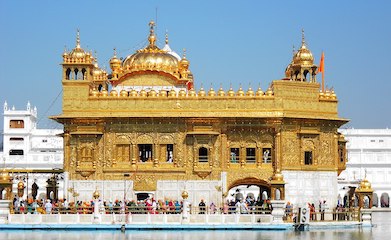
Punjab (India). A state in northwestern India. The Golden Temple is a gurdwara located in Amritsar, Punjab. It is the pre-eminent spiritual site of Sikhism.
Forming part of the larger Punjab region of the Indian subcontinent, the state is bordered by the Indian states of Himachal Pradesh to the north and northeast, Haryana to the south and southeast, and Rajasthan to the southwest; by the Indian union territories of Jammu and Kashmir to the north and Chandigarh to the east. To the west, it shares an international border with the identically named Pakistani province of Punjab, and as such is sometimes referred to as East Punjab or Indian Punjab for disambiguation purposes.
The state covers an area of 19,445 square miles (50,362 square kilometers), which is 1.53% of India’s total geographical area, making it the 19th-largest Indian state by area out of 28 Indian states (20th largest, if Union Territories are considered). With over 27 million inhabitants, Punjab is the 16th-largest Indian state by population, comprising 23 districts.
Punjabi, written in the Gurmukhi script, is the most widely spoken and the official language of the state.[10] The main ethnic group are the Punjabis, with Sikhs (57.7%) and Hindus (38.5%) forming the dominant religious groups. The state capital, Chandigarh, is a union territory and also the capital of the neighbouring state of Haryana. Three tributaries of the Indus River — the Sutlej, Beas, and Ravi — flow through Punjab.
The larger Punjab region was annexed by the British East India Company from the Sikh Empire in 1849. At the time of the independence of India from British rule in 1947, the Punjab province was partitioned along religious lines amidst widespread violence, with the Muslim-majority western portion becoming part of Pakistan and the Hindu- and Sikh-majority east remaining in India, causing a large-scale migration between the two.